The residency following the call to action Artivism, held at Cittadellarte from Monday 1st to Saturday 6th November, proposed five days of in-depth study on the close connection between environmental and social sustainability in fashion and art, with the participation of experts involved in the social and sustainable transformation of fashion, manufacturing, philosophy, international politics and activism. But before delving into the contents of the experience, we need to take a step back to the launch of the competition, aimed at redefining the narrative and paradigms of sustainable fashion through the contributions of those who are committed to highlighting the social and environmental sustainability of fashion through their artistic language. Behind the scenes of the project are Fashion Revolution Italia and Cittadellarte’s Fashion B.E.S.T., which, as reported in a previous article, conceived and organised the initiative and assessed the works and submissions received*, including videos, images, sound works, but also documentation of performances and events, participatory processes, community and relational interventions.
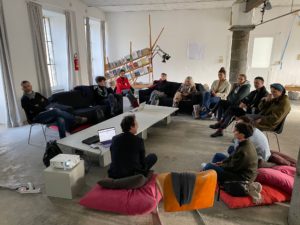
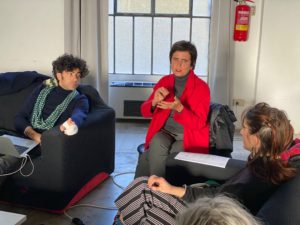
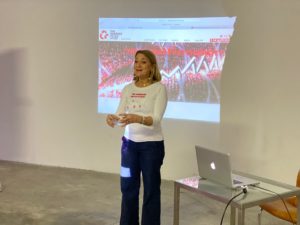

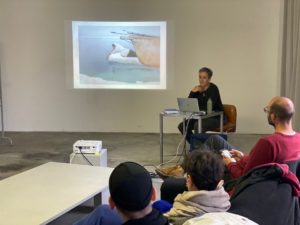
The exhibition and the finalists
The digital exhibition devoped from the call to action opened on 24th April 2021, during the Fashion Revolution Week. It showcased forty selected works, which could be visited in the digital space Ikonospace following an itinerary curated by Stella Stone. The jury then shortlisted the finalists who, as a further reward, would be able to take part in a residency at Cittadellarte sponsored by Fondazione Pistoletto itself, which was an opportunity for training, discussion and experience. The artists and fashion designers selected were Tiziano Guardini (Ecology of Mind), Charlaine Agbotsu (Via Pietrasanta), Antonella Valerio (Let’s Twist Again), Charles-Antoine Blais Métivier and Lieven Meyer (Survival Fashion), Anna Brugnera (sVESTITI), Chiara Gabriele (Re-Comporre), Hannes Egger (Everythings’s Changed – Nothing’s Changed), Andrea Bonfini (Fresh Meat), Giulia Perin (Verde), Olga A Pompidou (Paisajes) and Ora Nadia Shaulova (Ora. The thought of love). The latter passed away last June: a living absence, which during the residency the other participants made even more ‘perceived’ with a heartfelt and moving tribute, also including in the final restitution the screening of the film presenting the project with which Shaulova had participated in the call to action.
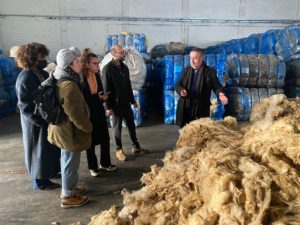
The residency
The authors of the ten projects chosen for the UNIDEE residency were able to study in depth the themes dealt with by their proposals, and their possible development together with the collective of Cittadellarte Fashion B.E.S.T. Biella Ethical Sustainable Think-Tank and Fashion Revolution. The experience proved to be “a creative ecosystem – explained the organisers – in which the profile of the artist-activist-artivist emerges, today more than ever, as an actor bearer of responsibility necessary for the future. We live in a historical moment in which the disconnection between natural, social and economic systems has deprived the contemporary designer of their primary function: to respond to humanity’s real needs. And bridging this disconnection is imperative”. In order to articulate the formative and inspirational process, the residents benefitted from the contribution of the staff of Cittadellarte and Fashion Revolution: Paolo Naldini (CEO and director of Cittadellarte – Fondazione Pistoletto), Olga Pirazzi (project manager of Fashion B.E.S.T. ), Juan Esteban Sandoval (director of Cittadellarte’s Art Office and of UNIDEE Residency Programs), Michele Cerruti But (academic coordinator of Accademia Unidee), Marina Spadafora (national coordinator of Fashion Revolution Italia) and Stella Stone (who curated the Artivism exhibition), as well as a series of guests and mentors: fashion designer Fabrizio Consoli, artist Maria Cristina Finucci (click here to view our interview with the president of The Garbace Patch State), artist Claudia Losi, researcher Alessia Patrucco (STIIMA-CNR Biella). The participants also had the opportunity to visit two iconic textile businesses in the Biella area: Filatura Astro in Vigliano Biellese and the consortium Biella The Wool Company at Lanificio Botto in Miagliano, where they explored in detail the site of the Biella Museum Network led by Nigel Thompson.
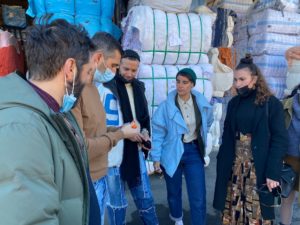

The restitution
In the afternoon of Friday 5th November the curtain was drawn on the residency with the final restitution by the participants. A moment of sharing that saw the artists highlight the peculiarities of their projects and discuss them with the representatives of Cittadellarte, Fashion Revolution and the ITS-TAM school, a technical high school in Biella. What emerged was a heterogeneous plurality of interventions, projects and ideas differing in language and content, but united by a critical, innovative and creative spirit aimed at raising social awareness of the binomial fashion-sustainability. Olga A Pompidou focused on her permaculture project, on the strong link between her artistic approach and the earth, and on the use of water: “Since the production of garments requires a lot of water, I use rainwater for my products whenever possible”; the artist then focused on the residency, which she described as “useful and constructive”. Antonella Valerio, after talking about her background in textile design, shared the guidelines of her research: “I have been working on waste and delocalisation, trying to get my practice closer to what it means to make things, also in light of the fact that consumers have lost their connection with the people who make things. I believe that sustainability is a way of life”. Andrea Bonfini, who defines himself as a ‘fashion craftsman’, offered an insight into his professional life: “I worked as a fashion designer in big companies for six years, but I was not satisfied. I wanted to create a brand that represented me in all respects, inclusive as well as sustainable. Creating an item of clothing is like baking a cake: the result has to be beautiful, good and healthy. Each of my garments is unique and I work with upcycling materials”. Chiara Gabriele instead proposed her practice of reuse, symbolically working with tights (“they are often used and thrown away”) and unused materials (“I asked Italian knitwear manufacturers to send me their waste, including denim, to work on”); she told us that she felt “positive vibrations that stimulated her desire to start creating”. Tiziano Guardini illustrated the guidelines of his brand and dwelt on the link that his collection has with the green sector: “I live in connection with nature, with an almost elfin vision. We are missing out on so much knowledge and energy from the planet, which we do not possess, we simply live on. In thebeginning sustainability was associated with deprivation, but that is not the case now: real change happens when all people can choose to be responsible with their choices and actions”.

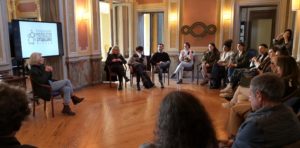
Visual artist Hannes Egger focused on the artistic research he conducted during the COVID-19 health emergency: one of the things he did during the lockdown was renting a sail advertising truck that bore the inscriptions, in English, Everythings’s Changed on one side and Nothing’s Changed on the other, in reference to the pandemic. “It was particularly significant when the truck went round roundabouts,”he explained, “because both sides became visible”. Charlaine Agbotsu shared the details of her photographic project aimed at making people reflect on the waste and abandonment of clothing and, with this in mind, she also created a collection based on the recovery of garments by looking for waste material from markets and other contexts (“my aim was to give value back to what was no longer used”). Anna Brugnera, a recent graduate student, highlighted her introspective work: “My project started in my wardrobe. I took out all the clothes and read their labels, and I realised that almost all of them came from places I had never seen. I then matched each of my garments with a photograph depicting a beauty spot of the country it came from”. The result was a work of self-analysis that turned the spotlight not on the dramatic spectacle but on various sparks of beauty from the different nations by gathering the pictures in a special book she defined an ‘atlas’ or ‘travel diary’: “I wanted to highlight the beauty that hides behind pain”, she said. Marta Ciolkoswka, who took part in the residency as the winner of the call Sustainable Views, was also present for the occasion. The Polish artist focused on her installation Social Toilet – representing its critical message towards social media and telephone devices – and the video work Bottlefield.

